Integration cross-modality data using SCALEX
The following tutorial demonstrates how to use SCALEX for integrating scRNA-seq and scATAC-seq data
There are mainly two steps:
Create a gene activity matrix from scATAC-seq data. This step follows the standard workflow of Signac for scATAC-seq data analysis. We uses the function GeneActivity of Signac and calculate the activity of each gene in the genome by assessing the chromatin accessibility associated with each gene, and create a new gene activity matrix derived from the scATAC-seq data. More details are here.
Integrate. We regard gene expression matrix and gene activity matrix as two batches of one dataset and use SCALEX for integration.
For this tutorial, we used a cross-modality PBMC data between scRNA-seq and scATAC-seq provided by 10X Genomics, and both scRNA-seq and scATAC-seq data are available through the 10x Genomics website.
Create a gene activity matrix (R)
[1]:
suppressPackageStartupMessages(library(Signac))
suppressPackageStartupMessages(library(Seurat))
suppressPackageStartupMessages(library(GenomeInfoDb))
suppressPackageStartupMessages(library(EnsDb.Hsapiens.v75))
suppressPackageStartupMessages(library(ggplot2))
suppressPackageStartupMessages(library(patchwork))
set.seed(1234)
options(warn=-1)
Pre-processing
We follow the pre-processing workflow of Signac when pre-processing chromatin data. First we creat a Seurat object by two related input files: cell matrix and fragment file.
[2]:
counts <- Read10X_h5(filename = "atac_v1_pbmc_10k_filtered_peak_bc_matrix.h5")
metadata <- read.csv(
file = "atac_v1_pbmc_10k_singlecell.csv",
header = TRUE,
row.names = 1
)
chrom_assay <- CreateChromatinAssay(
counts = counts,
sep = c(":", "-"),
genome = 'hg19',
fragments = 'atac_v1_pbmc_10k_fragments.tsv.gz',
min.cells = 10,
min.features = 200
)
pbmc <- CreateSeuratObject(
counts = chrom_assay,
assay = "peaks",
meta.data = metadata
)
Computing hash
Now add gene annotations to the pbmc object for the human genome. genome is suggested to be as same as the genome for scRNA-seq reads mapping on.
[4]:
# extract gene annotations from EnsDb
annotations <- GetGRangesFromEnsDb(ensdb = EnsDb.Hsapiens.v75)
# change to UCSC style since the data was mapped to hg19
seqlevelsStyle(annotations) <- 'UCSC'
genome(annotations) <- "hg19"
# add the gene information to the object
Annotation(pbmc) <- annotations
Compute QC Metrics. If you don’t need to filter cells, ignore this step
[13]:
# compute nucleosome signal score per cell
pbmc <- NucleosomeSignal(object = pbmc)
# compute TSS enrichment score per cell
pbmc <- TSSEnrichment(object = pbmc, fast = FALSE)
# add blacklist ratio and fraction of reads in peaks
pbmc$pct_reads_in_peaks <- pbmc$peak_region_fragments / pbmc$passed_filters * 100
pbmc$blacklist_ratio <- pbmc$blacklist_region_fragments / pbmc$peak_region_fragments
Extracting TSS positions
Finding + strand cut sites
Finding - strand cut sites
Computing mean insertion frequency in flanking regions
Normalizing TSS score
[14]:
pbmc$high.tss <- ifelse(pbmc$TSS.enrichment > 2, 'High', 'Low')
TSSPlot(pbmc, group.by = 'high.tss') + NoLegend()
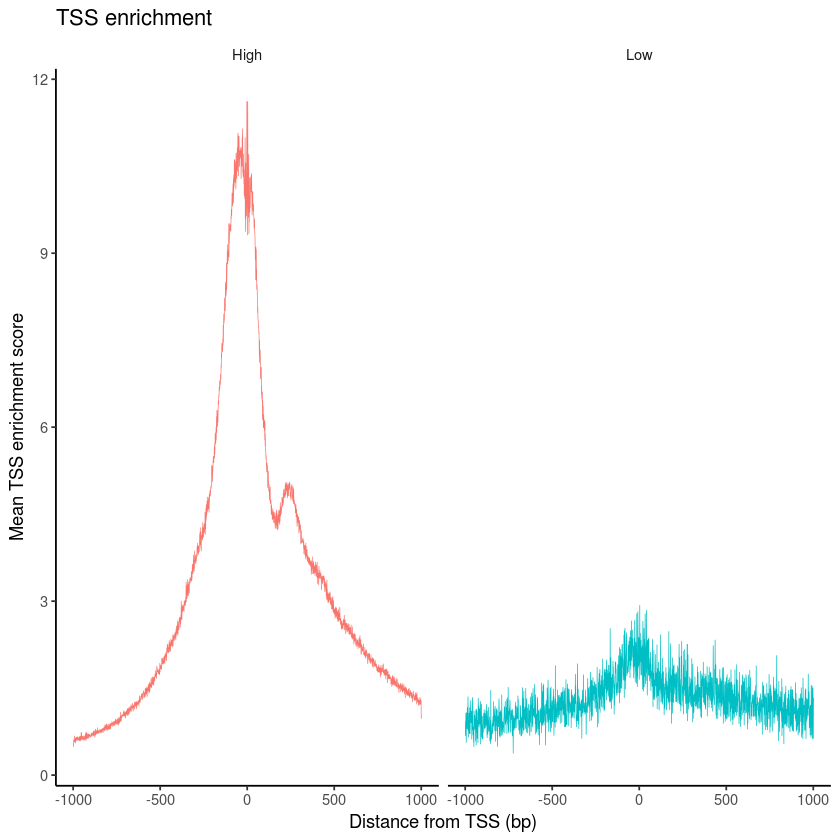
[15]:
pbmc$nucleosome_group <- ifelse(pbmc$nucleosome_signal > 4, 'NS > 4', 'NS < 4')
FragmentHistogram(object = pbmc, group.by = 'nucleosome_group')
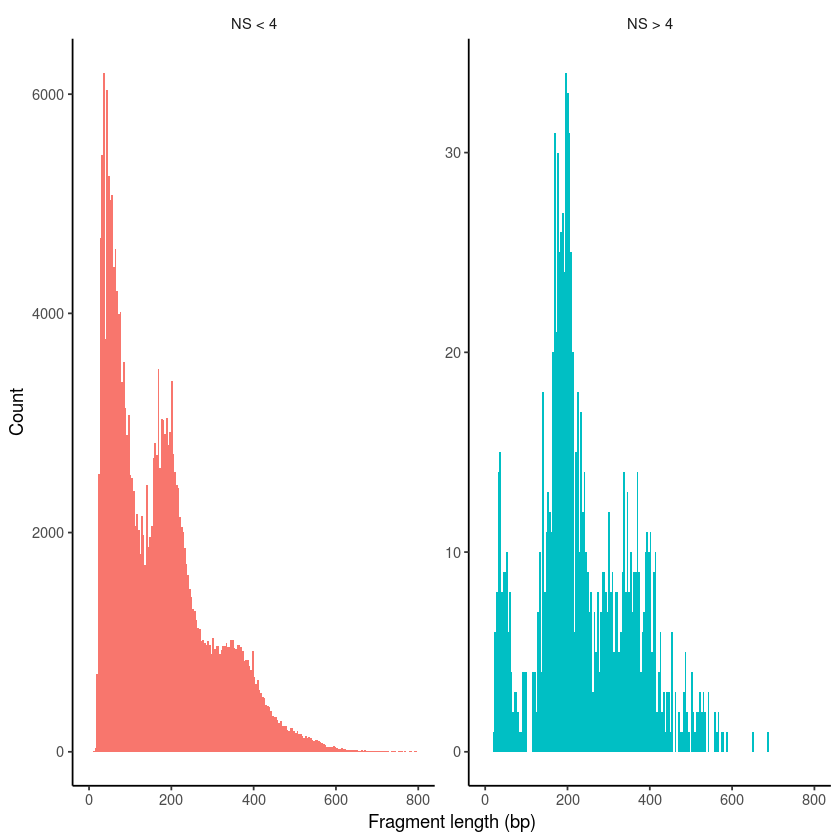
[16]:
VlnPlot(
object = pbmc,
features = c('pct_reads_in_peaks', 'peak_region_fragments',
'TSS.enrichment', 'blacklist_ratio', 'nucleosome_signal'),
pt.size = 0.1,
ncol = 5
)
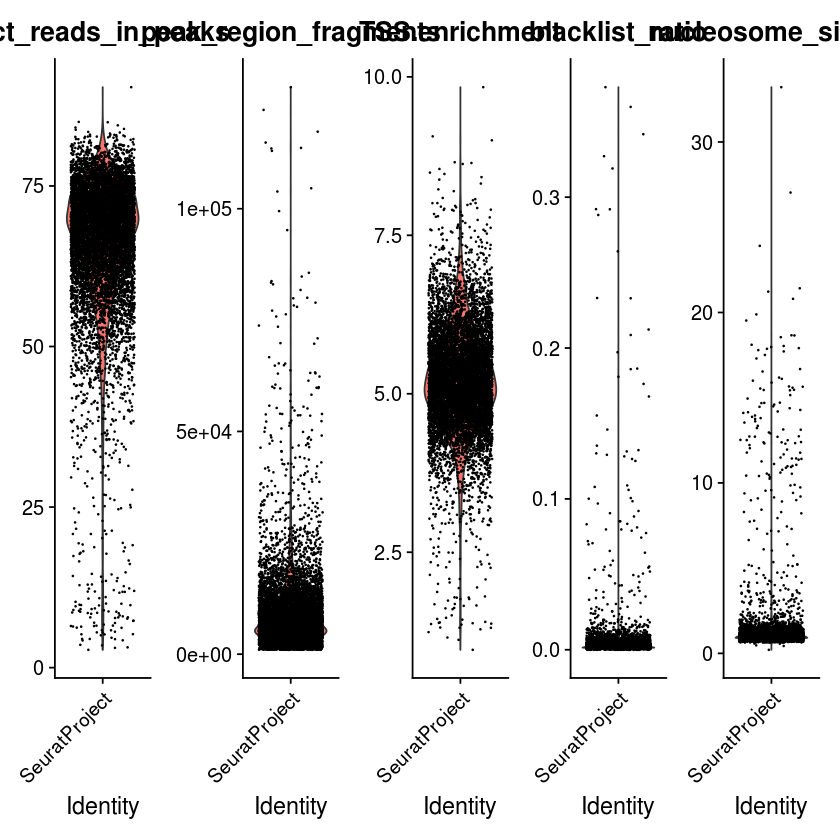
Filter cells that are outliers for the QC metrics.
[17]:
pbmc <- subset(
x = pbmc,
subset = peak_region_fragments > 3000 &
peak_region_fragments < 20000 &
pct_reads_in_peaks > 15 &
blacklist_ratio < 0.05 &
nucleosome_signal < 4 &
TSS.enrichment > 2
)
pbmc
An object of class Seurat
87561 features across 7060 samples within 1 assay
Active assay: peaks (87561 features, 0 variable features)
Calculate gene activity matrix by GeneActivity() function
[5]:
gene.activities <- GeneActivity(pbmc)
Extracting gene coordinates
Extracting reads overlapping genomic regions
save results
[ ]:
wk_dir <- './'
[2]:
write.table(t(gene.activities), paste(wk_dir,"gene_activity_score.txt",sep=''), sep='\t',quote = F)
Integrate (python)
Now you can use the gene_activity_score together with the gene expression matrix for integration.
You can run SCALE command line directly: SCALEX.py –data_list data1 data2 –batch_categories RNA ATAC -o output_path
data1: path or file of scRNA-seq data
data2: file of gene_activity_score
and here we show the results before integration and after integration.
[3]:
import scalex
from scalex import SCALEX
from scalex.plot import embedding
import scanpy as sc
import pandas as pd
import numpy as np
import matplotlib
from matplotlib import pyplot as plt
import seaborn as sns
[19]:
sc.settings.verbosity = 3
sc.settings.set_figure_params(dpi=80, facecolor='white',figsize=(3,3),frameon=True)
sc.logging.print_header()
plt.rcParams['axes.unicode_minus']=False
scanpy==1.7.0 anndata==0.7.5 umap==0.5.0 numpy==1.19.2 scipy==1.5.2 pandas==1.1.3 scikit-learn==0.23.2 statsmodels==0.12.0 python-igraph==0.9.0 leidenalg==0.8.3
[3]:
scalex.__version__
[3]:
'2.0.3.dev'
First we merge the RNA and ATAC data and add metadata information, and this processed data is available here
[ ]:
wk_dir = './'
[10]:
adata = sc.read_h5ad(wk_dir+'pbmc_RNA-ATAC.h5ad')
[11]:
adata
[11]:
AnnData object with n_obs × n_vars = 16492 × 13928
obs: 'celltype', 'tech', 'batch'
[12]:
sc.pp.filter_cells(adata, min_genes=0)
sc.pp.filter_genes(adata, min_cells=0)
sc.pp.normalize_total(adata, inplace=True)
sc.pp.log1p(adata)
sc.pp.highly_variable_genes(adata, n_top_genes=2000)
adata = adata[:, adata.var.highly_variable]
sc.pp.scale(adata, max_value=10)
sc.tl.pca(adata)
sc.pp.neighbors(adata, n_pcs=30, n_neighbors=30)
sc.tl.umap(adata, min_dist=0.1)
normalizing counts per cell
finished (0:00:00)
If you pass `n_top_genes`, all cutoffs are ignored.
extracting highly variable genes
finished (0:00:01)
--> added
'highly_variable', boolean vector (adata.var)
'means', float vector (adata.var)
'dispersions', float vector (adata.var)
'dispersions_norm', float vector (adata.var)
... as `zero_center=True`, sparse input is densified and may lead to large memory consumption
computing PCA
on highly variable genes
with n_comps=50
finished (0:00:02)
computing neighbors
using 'X_pca' with n_pcs = 30
finished: added to `.uns['neighbors']`
`.obsp['distances']`, distances for each pair of neighbors
`.obsp['connectivities']`, weighted adjacency matrix (0:00:14)
computing UMAP
finished: added
'X_umap', UMAP coordinates (adata.obsm) (0:00:29)
[15]:
sc.pl.umap(adata,color=['batch','celltype'],legend_fontsize=10, ncols=2)
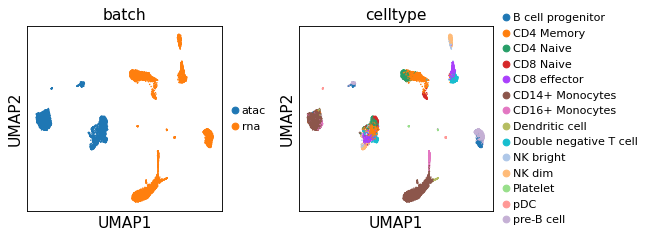
[16]:
wk_dir='./' # wk_dir is your local path to store data and results
[17]:
adata = SCALEX(data_list = [wk_dir+'RNA-ATAC.h5ad'],
min_features=0,
min_cells=0,
outdir=wk_dir+'/pbmc_RNA_ATAC/',
show=False,
gpu=7)
2021-03-26 11:46:17,234 - root - INFO - Raw dataset shape: (16492, 13928)
2021-03-26 11:46:17,237 - root - INFO - Preprocessing
2021-03-26 11:46:17,260 - root - INFO - Filtering cells
Trying to set attribute `.obs` of view, copying.
2021-03-26 11:46:21,627 - root - INFO - Filtering features
2021-03-26 11:46:24,745 - root - INFO - Normalizing total per cell
normalizing counts per cell
finished (0:00:00)
2021-03-26 11:46:25,022 - root - INFO - Log1p transforming
2021-03-26 11:46:26,014 - root - INFO - Finding variable features
If you pass `n_top_genes`, all cutoffs are ignored.
extracting highly variable genes
finished (0:00:03)
--> added
'highly_variable', boolean vector (adata.var)
'means', float vector (adata.var)
'dispersions', float vector (adata.var)
'dispersions_norm', float vector (adata.var)
2021-03-26 11:46:30,637 - root - INFO - Batch specific maxabs scaling
2021-03-26 11:46:32,857 - root - INFO - Processed dataset shape: (16492, 2000)
2021-03-26 11:46:32,908 - root - INFO - model
VAE(
(encoder): Encoder(
(enc): NN(
(net): ModuleList(
(0): Block(
(fc): Linear(in_features=2000, out_features=1024, bias=True)
(norm): BatchNorm1d(1024, eps=1e-05, momentum=0.1, affine=True, track_running_stats=True)
(act): ReLU()
)
)
)
(mu_enc): NN(
(net): ModuleList(
(0): Block(
(fc): Linear(in_features=1024, out_features=10, bias=True)
)
)
)
(var_enc): NN(
(net): ModuleList(
(0): Block(
(fc): Linear(in_features=1024, out_features=10, bias=True)
)
)
)
)
(decoder): NN(
(net): ModuleList(
(0): Block(
(fc): Linear(in_features=10, out_features=2000, bias=True)
(norm): DSBatchNorm(
(bns): ModuleList(
(0): BatchNorm1d(2000, eps=1e-05, momentum=0.1, affine=True, track_running_stats=True)
(1): BatchNorm1d(2000, eps=1e-05, momentum=0.1, affine=True, track_running_stats=True)
)
)
(act): Sigmoid()
)
)
)
)
Epochs: 100%|██████████| 117/117 [06:54<00:00, 3.54s/it, recon_loss=274.876,kl_loss=2.892]
2021-03-26 11:53:35,672 - root - INFO - Output dir: .//pbmc_RNA_ATAC//
2021-03-26 11:53:45,553 - root - INFO - Plot umap
computing neighbors
finished: added to `.uns['neighbors']`
`.obsp['distances']`, distances for each pair of neighbors
`.obsp['connectivities']`, weighted adjacency matrix (0:00:03)
computing UMAP
finished: added
'X_umap', UMAP coordinates (adata.obsm) (0:00:26)
running Leiden clustering
finished: found 14 clusters and added
'leiden', the cluster labels (adata.obs, categorical) (0:00:05)
WARNING: saving figure to file pbmc_RNA_ATAC/umap.pdf
[20]:
sc.pl.umap(adata,color=['batch','celltype'],legend_fontsize=10, ncols=2)
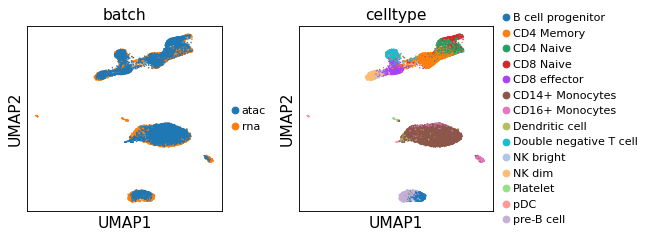
[ ]: